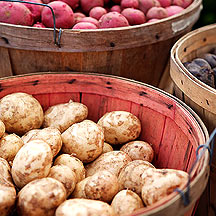By TARA PARKER-POPE
 Got organic milk? (Tony Cenicola/The New York Times)
Got organic milk? (Tony Cenicola/The New York Times)Switching to organic is tough for many families who don’t want to pay higher prices or give up their favorite foods. But by choosing organic versions of just a few foods that you eat often, you can increase the percentage of organic food in your diet without big changes to your shopping cart or your spending.
The key is to be strategic in your organic purchases. Opting for organic produce, for instance, doesn’t necessarily have a big impact, depending on what you eat. According to the Environmental Working Group, commercially-farmed fruits and vegetables vary in their levels of pesticide residue. Some vegetables, like broccoli, asparagus and onions, as well as foods with peels, such as avocados, bananas and oranges, have relatively low levels compared to other fruits and vegetables.
So how do you make your organic choices count? Pediatrician Dr. Alan Greene, whose new book “Raising Baby Green” explains how to raise a child in an environmentally-friendly way, has identified a few “strategic” organic foods that he says can make the biggest impact on the family diet.
1. Milk: “When you choose a glass of conventional milk, you are buying into a whole chemical system of agriculture,” says Dr. Greene. People who switch to organic milk typically do so because they are concerned about the antibiotics, artificial hormones and pesticides used in the commercial dairy industry. One recent United States Department of Agriculture survey found certain pesticides in about 30 percent of conventional milk samples and low levels in only one organic sample. The level is relatively low compared to some other foods, but many kids consume milk in large quantities.
2. Potatoes: Potatoes are a staple of the American diet — one survey found they account for 30 percent of our overall vegetable consumption. A simple switch to organic potatoes has the potential to have a big impact because commercially-farmed potatoes are some of the most pesticide-contaminated vegetables. A 2006 U.S.D.A. test found 81 percent of potatoes tested still contained pesticides after being washed and peeled, and the potato has one of the the highest pesticide contents of 43 fruits and vegetables tested, according to the Environmental Working Group.
 Go organic with kid favorites like peanut butter. (Lars Klove/The New York Times)
Go organic with kid favorites like peanut butter. (Lars Klove/The New York Times)3. Peanut butter: More acres are devoted to growing peanuts than any other fruits, vegetable or nut, according to the U.S.D.A. More than 99 percent of peanut farms use conventional farming practices, including the use of fungicide to treat mold, a common problem in peanut crops. Given that some kids eat peanut butter almost every day, this seems like a simple and practical switch. Commercial food firms now offer organic brands in the regular grocery store, but my daughter loves to go to the health food store and grind her own peanut butter.
4. Ketchup: For some families, ketchup accounts for a large part of the household vegetable intake. About 75 percent of tomato consumption is in the form of processed tomatoes, including juice, tomato paste and ketchup. Notably, recent research has shown organic ketchup has about double the antioxidants of conventional ketchup.
 Organic apples are readily available. (The New York Times)
Organic apples are readily available. (The New York Times)5. Apples: Apples are the second most commonly eaten fresh fruit, after bananas, and they are also used in the second most popular juice, after oranges, according to Dr. Greene. But apples are also one of the most pesticide-contaminated fruits and vegetables. The good news is that organic apples are easy to find in regular grocery stores.
For a complete list of Dr. Greene’s strategic organic choices, visit Organic Rx on his website.
from: http://well.blogs.nytimes.com/2007/10/22/five-easy-ways-to-go-organic/


